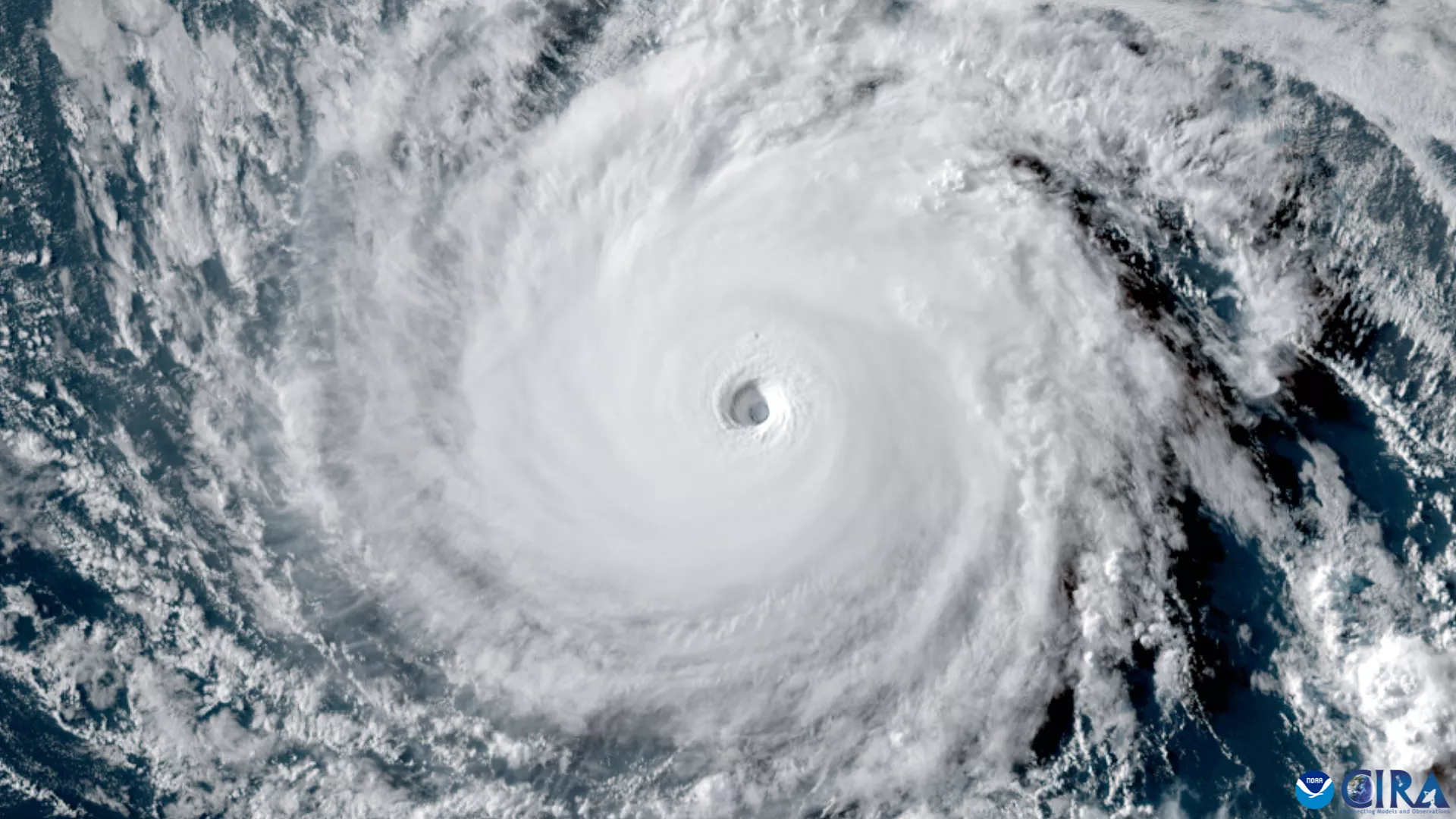
GeoColor image of Hurricane Dora in the Pacific from NOAA's GOES West satellite on August 6, 2023.
Tropical cyclones are among the most destructive weather phenomena. These intense rotating storm systems originate over warm tropical waters, have a typical diameter of around 120 to 300 miles, and are characterized by low atmospheric pressure, strong winds of at least 74 mph, and heavy rain.
Meteorologists use the overarching term “tropical cyclone” to describe these storms around the world, but they are also referred to by a variety of regional names based on where they form.
- Hurricanes: North Atlantic and the eastern/central North Pacific oceans. It is extremely rare for one to form in the South Atlantic Ocean.
- Cyclones: western South Pacific and Indian oceans
- Typhoons: western North Pacific (around the Philippines, Japan, and China)

Hurricanes
The term "hurricane" finds its roots in the Caribbean, where the indigenous Taíno people of the Greater Antilles worshiped a storm deity named Juracán. This god’s name may also have come from the Mayan god of wind, Huracan. The Spanish explorers later adopted the words "huracán" and “furacán” to describe these intense storms and brought them to Europe.
The word eventually became widespread in the English language as European colonial powers expanded their territories and often encountered these powerful storms in the Atlantic basin.
Huracán is also the source of the word “orkan,” another word for a particularly strong European windstorm.
Additionally, storms with characteristics similar to hurricanes/tropical cyclones occasionally form over the Mediterranean Sea. These are sometimes informally called “medicanes,” a combination of the words “Mediterranean” and “hurricane.”
Cyclones
The word "cyclone" has its origins in ancient Greek, though sources disagree on exactly which term. It was likely derived from either κύκλος (kúklos, “circle, wheel”) or κυκλόω (kuklóō, “go around in a circle, form a circle, encircle”), which fittingly describes the spiraling nature of these storms. However, "cyclone" was initially a term used to describe any system characterized by circular motion, including tornadoes and whirlpools.
But how did a Greek word come to describe these storms in a different region of the world? From the sixteen to late eighteen hundreds, sailors for the British East India Company would not have seen such storms near their homeland.
Sometime around 1840, Henry Piddington, an official with the East India Company who also studied meteorology, specifically adopted the term "cyclone" based on this root to describe tropical storms in the Indian Ocean and the South Pacific, since it was customary within academia to name things in Greek or Latin. It has since become the preferred term for these storms in these regions.
Typhoons
The word "typhoon" does not have as clear an origin as “hurricane” and “cyclone.” You could say that it’s a whirlwind of an etymology!
Like the word “cyclone,” the name of these storms might have a Greek basis due to European influence. Some believe that it comes from the Greek word, Τυφῶν (Typhôn), who was a dangerous mythological monster associated with the power of the winds. This word may have also had some influence on the Persian word, tūfīdan, which means “to roar or blow furiously.”
Portuguese sailors traveling through this part of the world also brought back the word tufão. This comes from a root that is based in both Urdu and Hindi—tūfān—which may in turn be derived from an even older Chinese word, tai fung, meaning “great wind.” This word has since evolved to become dà fēng in modern Mandarin Chinese, and taifū in modern Japanese.
Other scholars might even argue that the Arabic word, tāfa, may have contributed to the modern word as well, which means, “to turn around.”
Although we aren’t exactly sure exactly how it became the English word “typhoon” that we know today, it is likely that European sailors and traders in the South China Sea encountered these powerful storms and adopted the local terminology to describe them.
Why Don't We Standardize the Names?
Given the shared characteristics of these storms, standardizing a single name for them might seem logical. However, the current system of using different names serves several practical purposes:
- Tradition and Adaptation: These names have been used for centuries, and meteorological agencies have built forecasting and tracking systems around them. Changing the naming conventions would require significant adjustments in existing infrastructure and might lead to confusion.
- Geographical Relevance: The use of region-specific names helps in identifying and localizing storms for affected communities and emergency response personnel. Local names increase the sense of urgency and preparedness when a storm is approaching, as they feel more relevant to the people in the affected area.
- Cultural and Historical Significance: Retaining indigenous names preserves the cultural heritage of the affected regions. It acknowledges the long-standing relationship that communities have had with these storms and their efforts to cope with their devastating impacts.
While hurricanes, cyclones, and typhoons share the same attributes and are essentially the same type of storm, their names bear the imprints of history, culture, and geography. Understanding the origins behind these names provides us with a glimpse into the diverse ways in which humanity interacts with nature. Plus, by embracing the varied nomenclature, we acknowledge the significance of these storms in different parts of the world by respecting the experiences of the communities that have endured them throughout history.
Learn more about hurricanes and check out NOAA’s live Hurricane Tracker.
